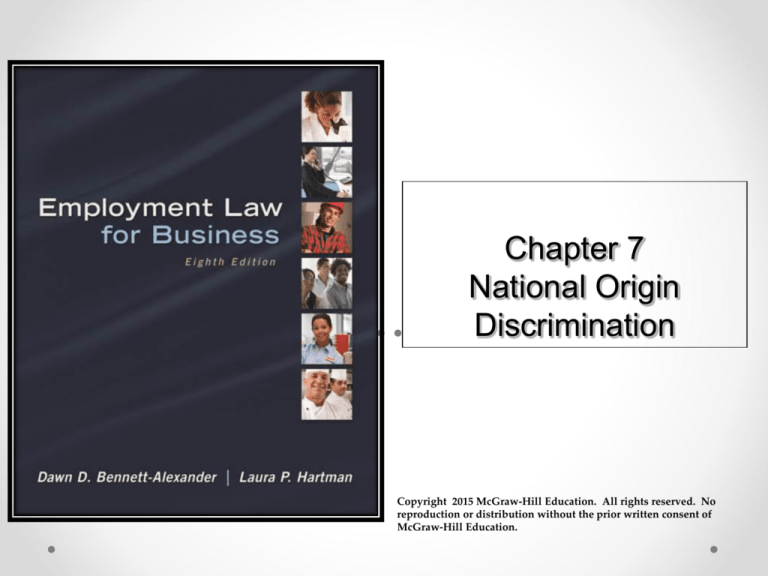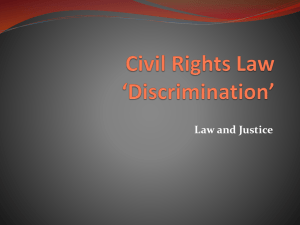
Chapter 7
National Origin
Discrimination
Copyright 2015 McGraw-Hill Education. All rights reserved. No
reproduction or distribution without the prior written consent of
McGraw-Hill Education.
Learning Objectives (1)
Describe the impact and implications of the
changing demographics on the American
workforce
Define the prima facie case for national origin
discrimination under Title VII
Explain the legal issues surrounding “Englishonly policies” in the workplace
7-2
Learning Objectives (2)
Describe a claim for harassment based on
national origin and discuss how it might be
different from one based on other protected
classes
Identify the difference between citizenship and
national origin
Explain the extent of protection under the
Immigration Reform and Control Act
7-3
Introduction
U.S. is a melting pot/salad bowl of different
cultures
An employment decision based on either race or
national origin is illegal
Statutes:
Title VII, Civil Rights Act of 1964 Sec. 703(a)
Immigration Reform and Control Act of 1986
Secs. 274A(a), Sec. 274(B)(a)
7-4
The Changing Workforce
By 2018, the U.S. workforce will be:
17.6 percent Hispanics
12.1 percent African-Americans
5.6 percent Asians
The median weekly earnings of foreign-born fulltime workers was significantly less than for nonforeign-born workers
Claims of national origin discrimination are the
fastest-growing category under Title VII
7-5
Regulatory Overview
National origin discrimination protection
offered by Title VII: It is unlawful for an
employer to limit, segregate, or classify
employees
In any way on the basis of national origin that would
deprive them of the privileges, benefits, or
opportunities of employment
7-6
National Origin: Prima facie case
Familiar Disparate Treatment and Disparate
Impact analyses apply
‘Member of the protected class:’ Significant
issue in these cases (next slide)
Language fluency may be issue in
qualifications
‘English-only’ rules as facially neutral policy in
Disparate Impact cases
7-7
Member of the Protected Class
Based only on country of origin, not on country
of citizenship
No protection based on status as aliens
Case: Cortezano v. Salin Bank & Trust Company
National origin encompasses:
Employee’s place of birth
Ethnic characteristics or origins
Physical, linguistic, or cultural traits closely associated
with a national origin group
7-8
Qualification/BFOQs
As always, claimant must show that s/he meets
the job’s requirements
BFOQs: employer may claim a specific national
origin is a legitimate job requirement
Compare: Japanese subsidiary preference for
Japanese nationals based on unique requirements of
international trade, but
Customer/co-worker preference is never a BFOQ
7-9
English Fluency as a qualification, and
Language Restrictions (1)
Language fluency and “English-only” policies
have become increasingly relevant in the
workplace
May be based on Disparate Treatment or Disparate
Impact
Employers should not permit arbitrarily imposed
language restrictions: consider alternatives
EEOC position: narrow availability, based on
business justifications
http://www.eeoc.gov/policy/docs/national-origin.html#VC
7-10
English Fluency as a qualification, and
Language Restrictions (2)
Courts have allowed restrictions where based on
sound business interests
May relate to qualifications, legitimate nondiscriminatory purpose or business necessity
Customer factors: “English-only on the sales floor,”
ability to be understood
Scenario 1
Fluency for supervisory control and/or safety
Case: Garcia v. Spun Steak
7-11
Adverse Employment Action and
Dissimilar Treatment
Adverse employment action: Any action or
omission that takes away a benefit, opportunity,
or privilege of employment from an employee
It includes
Demotion
Termination
Removal of privileges afforded to other employees
7-12
National Origin-based Harassment
Claims have been on a sharp increase
Familiar prima facie case elements
Must be unwelcome, severe or pervasive, cause
differential job difficulty, employer link
Common incidents include
Ethnic slurs, workplace graffiti, other offenses based
on presumed employee traits
Key consideration is effect on victim
7-13
OFCCP Guidelines on Discrimination
Because of Religion or National Origin (1)
Applies to federal agencies or employers who
supply goods or services to government entity
Individuals must be hired and retained without
regard to their religion or national origin
The guidelines require federal contractors to
prevent discrimination
Citation: http://www.ecfr.gov/cgi-bin/textidx?c=ecfr&sid=3b71cb5b215c393fe910604d33c9fed1&rg
n=div5&view=text&node=41:1.2.3.1.8&idno=41
7-14
OFCCP Guidelines on Discrimination
Because of Religion or National Origin (2)
Provisions include the following ethnic groups
Eastern, Middle, and Southern European ancestry,
including Jews, Catholics, Greeks, and Slavs
Excluded because of coverage elsewhere
Blacks
Spanish-surnamed Americans
Asians
Native Americans
7-15
Middle Eastern Discrimination After
September 11, 2001
“Code Z” established by EEOC in 2002
http://www.eeoc.gov/eeoc/newsroom/release/archive/5-15-02.html
Key discrimination issues
Different treatment due to attire
Ethnic harassment, particularly in relation to security
concerns
More stringent security checks or other preemployment requirements
Effective prevention – sensitivity to employee’s
concerns
7-16
Citizenship and the Immigration Reform
Control Act
Legal aliens are often restricted from access to
certain government or other positions by statute
“Political function” exception
Case: Espinoza v. Farah Manufacturing Company
Immigration Reform and Control Act
Unlawful to ‘knowlingly’ hire, recruit or refer aliens not
authorized to work in U.S.
‘Knowingly’ includes constructive knowledge (no
‘ostrich defense’)
7-17
Citizenship and the Immigration Reform
Control Act: Discrimination Claims
Provisions in both Title VII and IRCA
Title VII – Familiar Disparate Treatment and Disparate
Impact analyses
IRCA – requires that the adverse action be knowingly
and intentionally discriminatory
Innocent or negligent discrimination is a
complete defense to a claim of discrimination
under IRCA
7-18
Undocumented Workers (1)
IRCA makes it unlawful for employers to hire,
recruit, or refer for a fee to unauthorized workers
Employers are required to verify all newly hired
employees
Form I-9
“No-match” rule implemented in 2007: Bush
Administration focus on Employees
Supplemental Final Rule in October 2008
7-19
Undocumented Workers (2)
Obama administration focus on Employers
Rescinded “no-match” rule in 2009
Focused on civil and criminal actions against
employers that knowingly hired undocumented
workers
Immigration and Customs Enforcement (ICE)
IRCA
Employers subjected to random compliance
inspection under the General Administrative Plan
7-20
Undocumented Workers (3)
EEOC
Workers’ undocumented status does not justify
workplace discrimination
Employers may be liable for monetary remedies
Hoffman Plastic Compounds Inc. v. NLRB
Fair Labor Standards Act
Protects unauthorized workers from abuse
7-21
Alternate Basis for National Origin or
Citizenship Discrimination: Section 1981
Identifiable classes of persons who are
subjected to intentional discrimination solely
because of their ancestry or ethnic
characteristics
Section 1981 – discrimination because of what
they are
St. Francis College v. Al-Khazraji
Later cases: narrow interpretation
7-22
Management Tips (1)
Employees can file national origin discrimination
claims even if they have been simply perceived
to be of a particular origin
Customer, client, or co-worker preference,
comfort, or discomfort cannot be stated as the
source of BFOQ.
In case of BFOQs, ensure that only persons of that
origin are, in fact, selected
7-23
Management Tips (2)
Federal contractors must follow the Guidelines
on Discrimination Because of Religion or
National Origin
Before instituting a policy, consider the
implications of both Title VII and IRCA
Recognize the concerns of Middle Eastern
employees in the post-September 11 era
7-24








